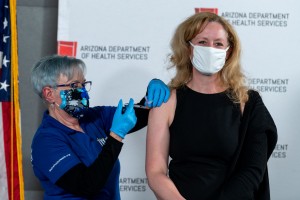 Last week, I had the privilege of being among a group of healthcare workers receiving some of the first COVID-19 vaccinations in Arizona. This was during an event held at ADHS.
Last week, I had the privilege of being among a group of healthcare workers receiving some of the first COVID-19 vaccinations in Arizona. This was during an event held at ADHS.
I was inspired by the reasons these professionals gave for wanting to get vaccinated right away, whether it was keeping patients, family, and friends safe or, as nurse Regina Villa said, so we can hug each other again.
For each of us, however, one of the main goals was showing that the vaccine is both safe and effective. With that in mind, I’m pleased to report that neither I, nor anyone else in our group, has reported any significant side effects from the vaccine. I initially had some soreness at the injection site, as happens when I get my flu vaccine, but that passed quickly.
None of this surprises me because of the way the two approved vaccines, along with those awaiting approval, have been developed with safety in mind.
COVID-19 vaccines have been studied in the same way that all vaccines are approved for use in the United States. While these particular vaccines have been made available in record time, the scientists developing them still have followed rigorous processes to demonstrate safety before the vaccines can be approved for use in the United States.
These steps involve three phases of vaccine testing. Phase 1 looks at vaccine safety by measuring the extent to which the vaccines are associated with local and generalized reactions in people. Not everyone has reactions to these vaccines. When there are reactions, local reactions can include pain, redness, and swelling at the injection site. Generalized reactions can include fever, fatigue, chills, muscle aches, joint pain, headache, or an allergic reaction. These reactions occur as the body’s immune system is responding to the vaccine.
If there are no safety concerns identified in phase 1, a vaccine moves into Phase 2 studies. These studies help determine the appropriate dose of vaccine that a person should get and the relationship between the dose size and a person’s immune system response. People participating in phase 2 studies are also monitored for local and generalized reactions.
Phase 3 of vaccine testing involves large numbers of people who are studied to see how well the vaccine protects against COVID-19. This is done by random assignment with half of the study volunteers receiving a COVID-19 vaccine and half receiving a placebo (an injection of harmless fluid). These two groups are then compared over time as to how well the vaccine protects vaccinated people against COVID-19, compared to the unvaccinated people. In phase 3, safety testing continues to be done by measuring local and generalized reactions and testing blood responses. Both the Pfizer and Moderna vaccines have had about 40,000 participants in their vaccine trials.
The Advisory Committee on Immunization Practices (ACIP) of the Centers for Disease Control and Prevention (CDC) has held frequent public meetings on the ongoing COVID-19 vaccine studies. ACIP has reviewed information from five different vaccine manufacturers on phase 1 and phase 2 reactions to their COVID-19 vaccines. With each vaccine, common side effects have included pain at the vaccination site, fatigue, and headache, with most of the reactions being mild or moderate.
Once the phase 3 part of each vaccine trial is finished, if a COVID-19 vaccine is shown to be safe and effective at preventing COVID-19, the manufacturer then submits an Emergency Use Authorization application for review by the Food and Drug Administration (FDA), which has determined that the Pfizer and Moderna vaccines are safe, effective, and worthy of an Emergency Use Authorization with instructions on how the vaccine is to be used.
These two vaccines, likely to be followed by others, will be made available to Arizonans over the next several months and will help prevent future spread of COVID-19. I urge you to get the vaccine when it is your turn in line. In the meantime, I encourage everyone to continue COVID-19 prevention efforts: Minimize gatherings with people who don’t live with you, wear a mask, maintain physical distance, and stay home if you are sick.









